Managerial Economics: Problem Set #6 Analysis and Solutions
VerifiedAdded on 2022/10/06
|8
|1550
|24
Homework Assignment
AI Summary
This assignment solution addresses key concepts in managerial economics, including the impact of money supply on real economic factors in the short run, the importance of stable inflation rates, and the differences between active and passive monetary policies. The solution analyzes the effects of both contractionary and expansionary monetary policies on real GDP, price levels, and unemployment rates using the aggregate supply-aggregate demand model. It explains how changes in money supply influence investment, production, employment, and overall economic equilibrium, providing a detailed understanding of macroeconomic principles and their practical applications. The assignment also includes graphical representations to illustrate the effects of these policies on the economy's equilibrium.
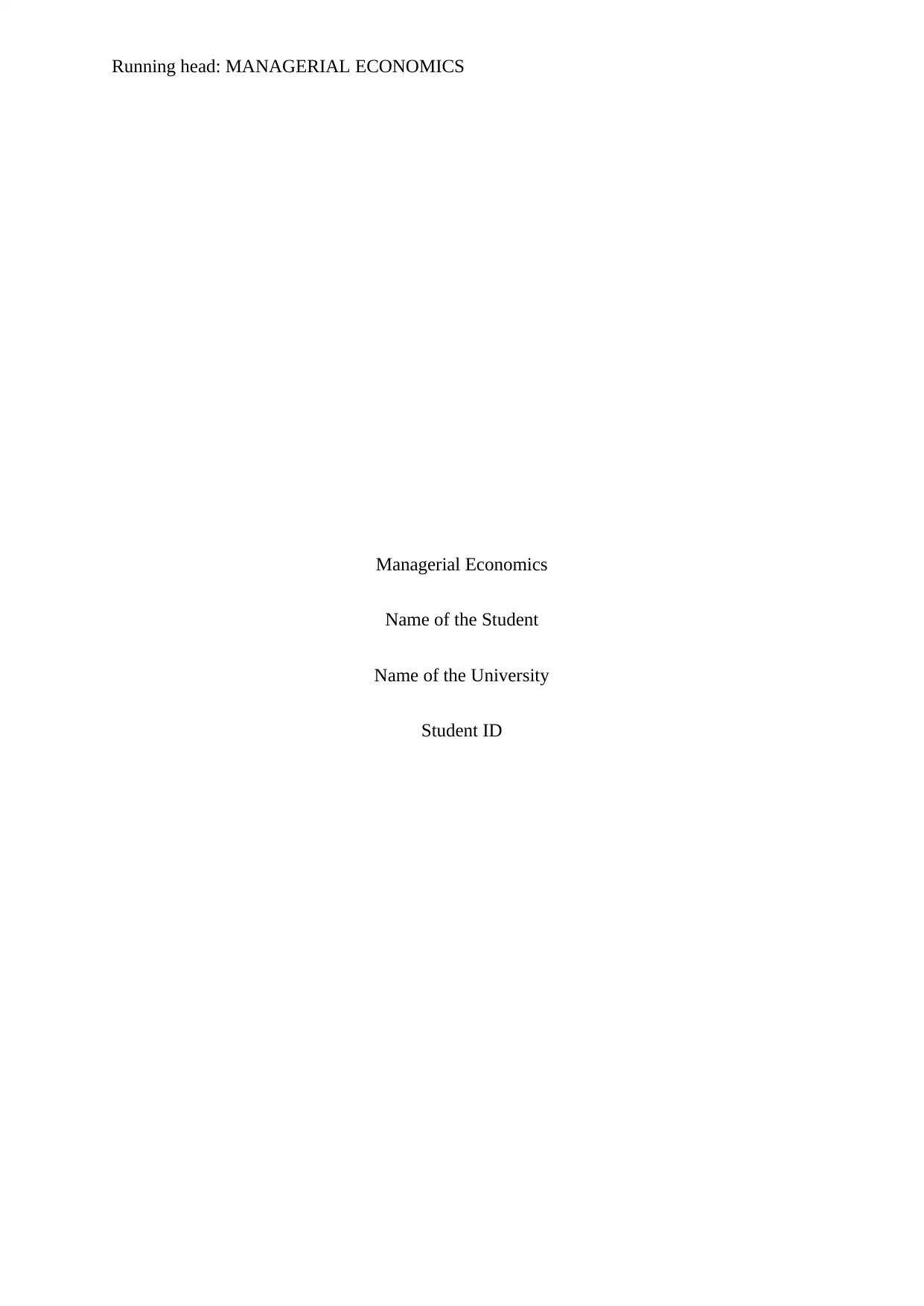
Running head: MANAGERIAL ECONOMICS
Managerial Economics
Name of the Student
Name of the University
Student ID
Managerial Economics
Name of the Student
Name of the University
Student ID
Paraphrase This Document
Need a fresh take? Get an instant paraphrase of this document with our AI Paraphraser
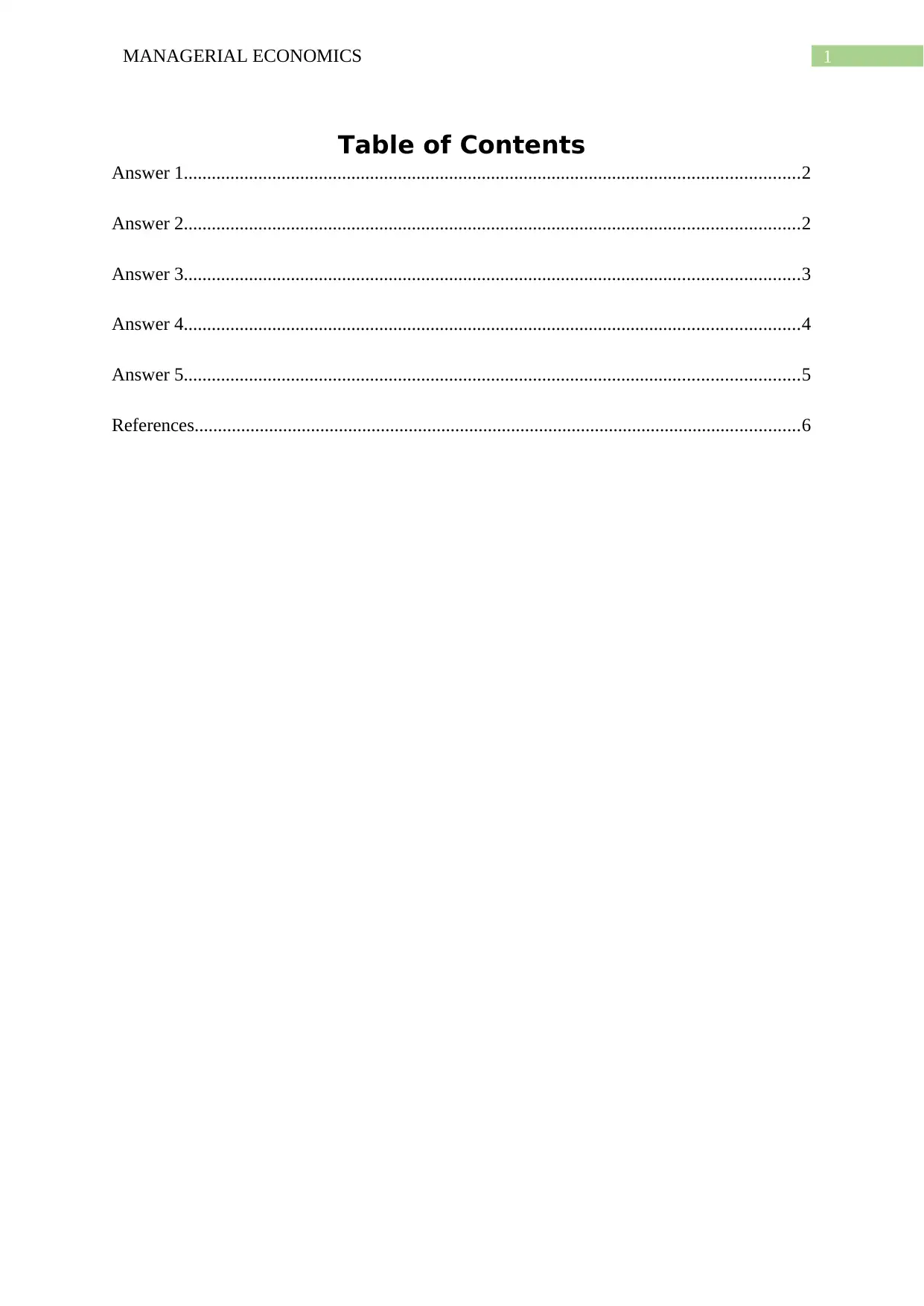
1MANAGERIAL ECONOMICS
Table of Contents
Answer 1....................................................................................................................................2
Answer 2....................................................................................................................................2
Answer 3....................................................................................................................................3
Answer 4....................................................................................................................................4
Answer 5....................................................................................................................................5
References..................................................................................................................................6
Table of Contents
Answer 1....................................................................................................................................2
Answer 2....................................................................................................................................2
Answer 3....................................................................................................................................3
Answer 4....................................................................................................................................4
Answer 5....................................................................................................................................5
References..................................................................................................................................6
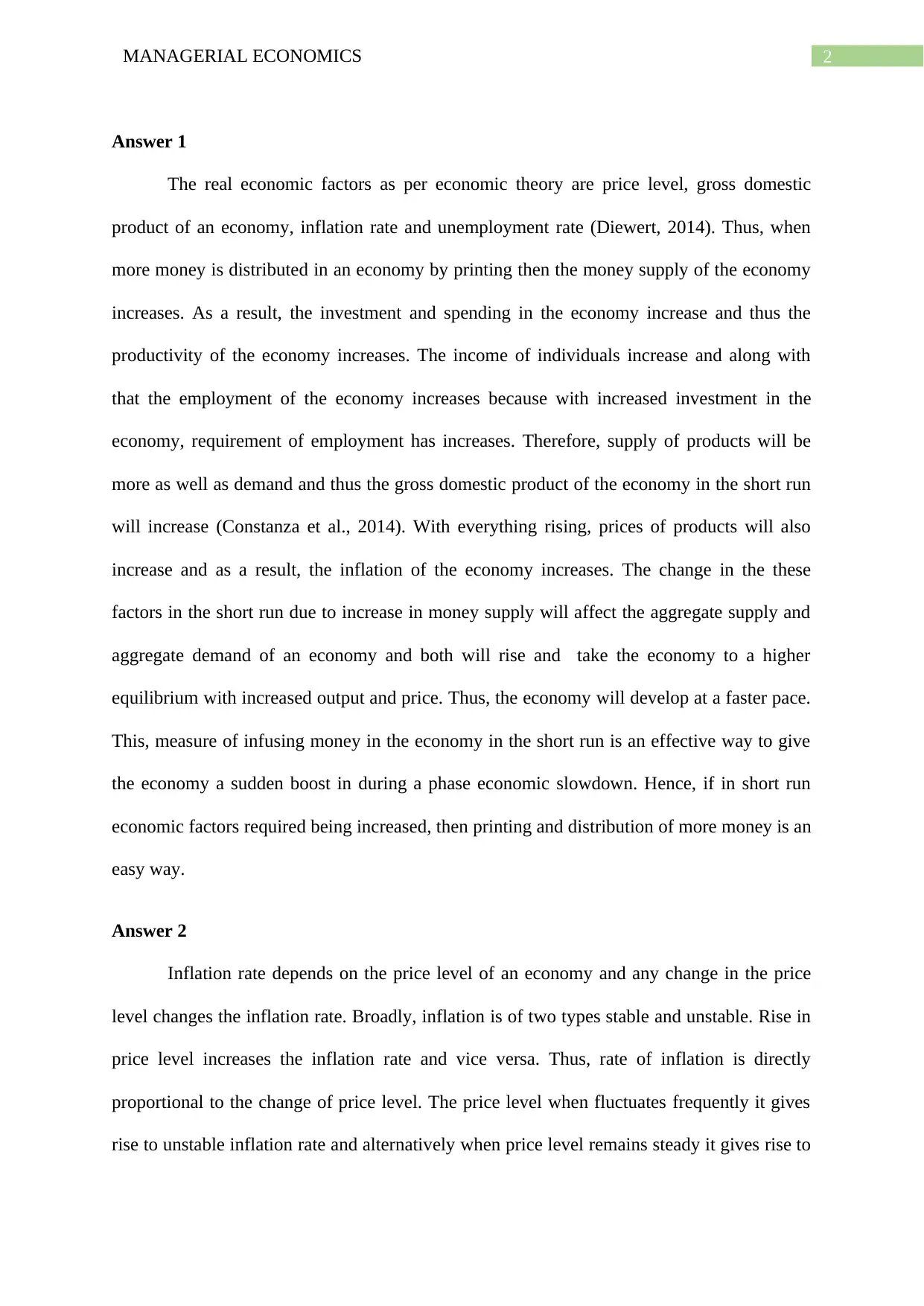
2MANAGERIAL ECONOMICS
Answer 1
The real economic factors as per economic theory are price level, gross domestic
product of an economy, inflation rate and unemployment rate (Diewert, 2014). Thus, when
more money is distributed in an economy by printing then the money supply of the economy
increases. As a result, the investment and spending in the economy increase and thus the
productivity of the economy increases. The income of individuals increase and along with
that the employment of the economy increases because with increased investment in the
economy, requirement of employment has increases. Therefore, supply of products will be
more as well as demand and thus the gross domestic product of the economy in the short run
will increase (Constanza et al., 2014). With everything rising, prices of products will also
increase and as a result, the inflation of the economy increases. The change in the these
factors in the short run due to increase in money supply will affect the aggregate supply and
aggregate demand of an economy and both will rise and take the economy to a higher
equilibrium with increased output and price. Thus, the economy will develop at a faster pace.
This, measure of infusing money in the economy in the short run is an effective way to give
the economy a sudden boost in during a phase economic slowdown. Hence, if in short run
economic factors required being increased, then printing and distribution of more money is an
easy way.
Answer 2
Inflation rate depends on the price level of an economy and any change in the price
level changes the inflation rate. Broadly, inflation is of two types stable and unstable. Rise in
price level increases the inflation rate and vice versa. Thus, rate of inflation is directly
proportional to the change of price level. The price level when fluctuates frequently it gives
rise to unstable inflation rate and alternatively when price level remains steady it gives rise to
Answer 1
The real economic factors as per economic theory are price level, gross domestic
product of an economy, inflation rate and unemployment rate (Diewert, 2014). Thus, when
more money is distributed in an economy by printing then the money supply of the economy
increases. As a result, the investment and spending in the economy increase and thus the
productivity of the economy increases. The income of individuals increase and along with
that the employment of the economy increases because with increased investment in the
economy, requirement of employment has increases. Therefore, supply of products will be
more as well as demand and thus the gross domestic product of the economy in the short run
will increase (Constanza et al., 2014). With everything rising, prices of products will also
increase and as a result, the inflation of the economy increases. The change in the these
factors in the short run due to increase in money supply will affect the aggregate supply and
aggregate demand of an economy and both will rise and take the economy to a higher
equilibrium with increased output and price. Thus, the economy will develop at a faster pace.
This, measure of infusing money in the economy in the short run is an effective way to give
the economy a sudden boost in during a phase economic slowdown. Hence, if in short run
economic factors required being increased, then printing and distribution of more money is an
easy way.
Answer 2
Inflation rate depends on the price level of an economy and any change in the price
level changes the inflation rate. Broadly, inflation is of two types stable and unstable. Rise in
price level increases the inflation rate and vice versa. Thus, rate of inflation is directly
proportional to the change of price level. The price level when fluctuates frequently it gives
rise to unstable inflation rate and alternatively when price level remains steady it gives rise to
⊘ This is a preview!⊘
Do you want full access?
Subscribe today to unlock all pages.

Trusted by 1+ million students worldwide
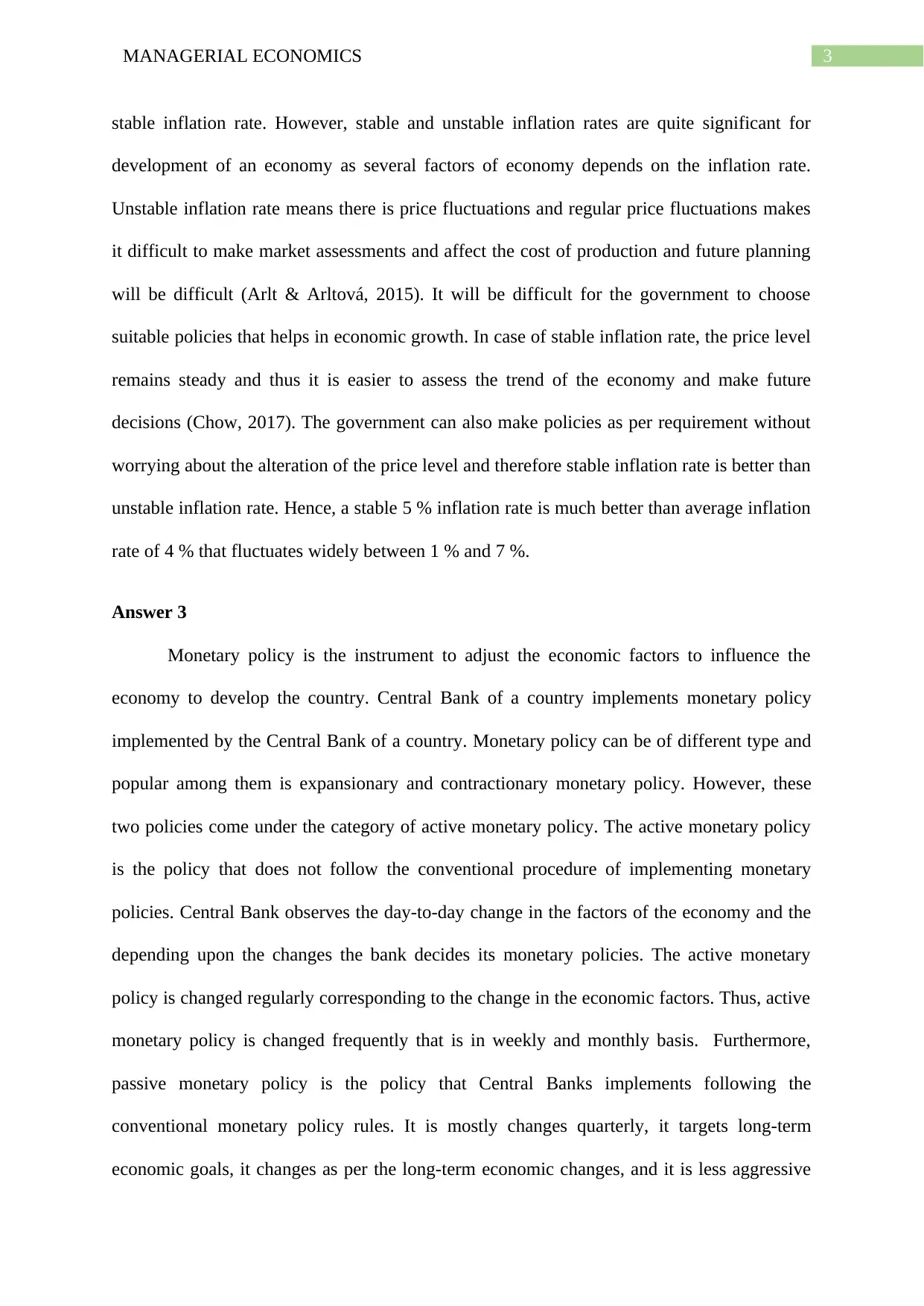
3MANAGERIAL ECONOMICS
stable inflation rate. However, stable and unstable inflation rates are quite significant for
development of an economy as several factors of economy depends on the inflation rate.
Unstable inflation rate means there is price fluctuations and regular price fluctuations makes
it difficult to make market assessments and affect the cost of production and future planning
will be difficult (Arlt & Arltová, 2015). It will be difficult for the government to choose
suitable policies that helps in economic growth. In case of stable inflation rate, the price level
remains steady and thus it is easier to assess the trend of the economy and make future
decisions (Chow, 2017). The government can also make policies as per requirement without
worrying about the alteration of the price level and therefore stable inflation rate is better than
unstable inflation rate. Hence, a stable 5 % inflation rate is much better than average inflation
rate of 4 % that fluctuates widely between 1 % and 7 %.
Answer 3
Monetary policy is the instrument to adjust the economic factors to influence the
economy to develop the country. Central Bank of a country implements monetary policy
implemented by the Central Bank of a country. Monetary policy can be of different type and
popular among them is expansionary and contractionary monetary policy. However, these
two policies come under the category of active monetary policy. The active monetary policy
is the policy that does not follow the conventional procedure of implementing monetary
policies. Central Bank observes the day-to-day change in the factors of the economy and the
depending upon the changes the bank decides its monetary policies. The active monetary
policy is changed regularly corresponding to the change in the economic factors. Thus, active
monetary policy is changed frequently that is in weekly and monthly basis. Furthermore,
passive monetary policy is the policy that Central Banks implements following the
conventional monetary policy rules. It is mostly changes quarterly, it targets long-term
economic goals, it changes as per the long-term economic changes, and it is less aggressive
stable inflation rate. However, stable and unstable inflation rates are quite significant for
development of an economy as several factors of economy depends on the inflation rate.
Unstable inflation rate means there is price fluctuations and regular price fluctuations makes
it difficult to make market assessments and affect the cost of production and future planning
will be difficult (Arlt & Arltová, 2015). It will be difficult for the government to choose
suitable policies that helps in economic growth. In case of stable inflation rate, the price level
remains steady and thus it is easier to assess the trend of the economy and make future
decisions (Chow, 2017). The government can also make policies as per requirement without
worrying about the alteration of the price level and therefore stable inflation rate is better than
unstable inflation rate. Hence, a stable 5 % inflation rate is much better than average inflation
rate of 4 % that fluctuates widely between 1 % and 7 %.
Answer 3
Monetary policy is the instrument to adjust the economic factors to influence the
economy to develop the country. Central Bank of a country implements monetary policy
implemented by the Central Bank of a country. Monetary policy can be of different type and
popular among them is expansionary and contractionary monetary policy. However, these
two policies come under the category of active monetary policy. The active monetary policy
is the policy that does not follow the conventional procedure of implementing monetary
policies. Central Bank observes the day-to-day change in the factors of the economy and the
depending upon the changes the bank decides its monetary policies. The active monetary
policy is changed regularly corresponding to the change in the economic factors. Thus, active
monetary policy is changed frequently that is in weekly and monthly basis. Furthermore,
passive monetary policy is the policy that Central Banks implements following the
conventional monetary policy rules. It is mostly changes quarterly, it targets long-term
economic goals, it changes as per the long-term economic changes, and it is less aggressive
Paraphrase This Document
Need a fresh take? Get an instant paraphrase of this document with our AI Paraphraser
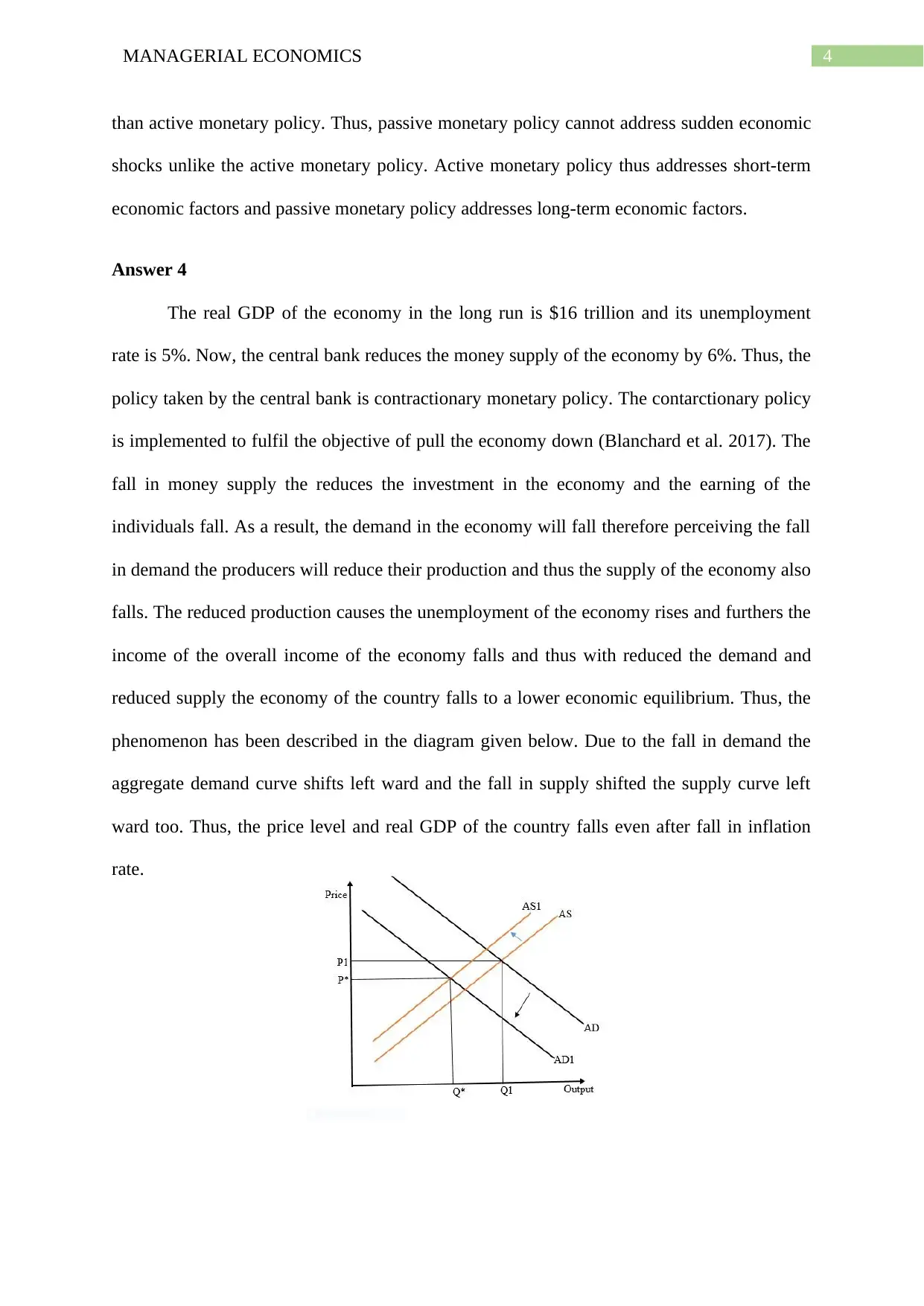
4MANAGERIAL ECONOMICS
than active monetary policy. Thus, passive monetary policy cannot address sudden economic
shocks unlike the active monetary policy. Active monetary policy thus addresses short-term
economic factors and passive monetary policy addresses long-term economic factors.
Answer 4
The real GDP of the economy in the long run is $16 trillion and its unemployment
rate is 5%. Now, the central bank reduces the money supply of the economy by 6%. Thus, the
policy taken by the central bank is contractionary monetary policy. The contarctionary policy
is implemented to fulfil the objective of pull the economy down (Blanchard et al. 2017). The
fall in money supply the reduces the investment in the economy and the earning of the
individuals fall. As a result, the demand in the economy will fall therefore perceiving the fall
in demand the producers will reduce their production and thus the supply of the economy also
falls. The reduced production causes the unemployment of the economy rises and furthers the
income of the overall income of the economy falls and thus with reduced the demand and
reduced supply the economy of the country falls to a lower economic equilibrium. Thus, the
phenomenon has been described in the diagram given below. Due to the fall in demand the
aggregate demand curve shifts left ward and the fall in supply shifted the supply curve left
ward too. Thus, the price level and real GDP of the country falls even after fall in inflation
rate.
than active monetary policy. Thus, passive monetary policy cannot address sudden economic
shocks unlike the active monetary policy. Active monetary policy thus addresses short-term
economic factors and passive monetary policy addresses long-term economic factors.
Answer 4
The real GDP of the economy in the long run is $16 trillion and its unemployment
rate is 5%. Now, the central bank reduces the money supply of the economy by 6%. Thus, the
policy taken by the central bank is contractionary monetary policy. The contarctionary policy
is implemented to fulfil the objective of pull the economy down (Blanchard et al. 2017). The
fall in money supply the reduces the investment in the economy and the earning of the
individuals fall. As a result, the demand in the economy will fall therefore perceiving the fall
in demand the producers will reduce their production and thus the supply of the economy also
falls. The reduced production causes the unemployment of the economy rises and furthers the
income of the overall income of the economy falls and thus with reduced the demand and
reduced supply the economy of the country falls to a lower economic equilibrium. Thus, the
phenomenon has been described in the diagram given below. Due to the fall in demand the
aggregate demand curve shifts left ward and the fall in supply shifted the supply curve left
ward too. Thus, the price level and real GDP of the country falls even after fall in inflation
rate.
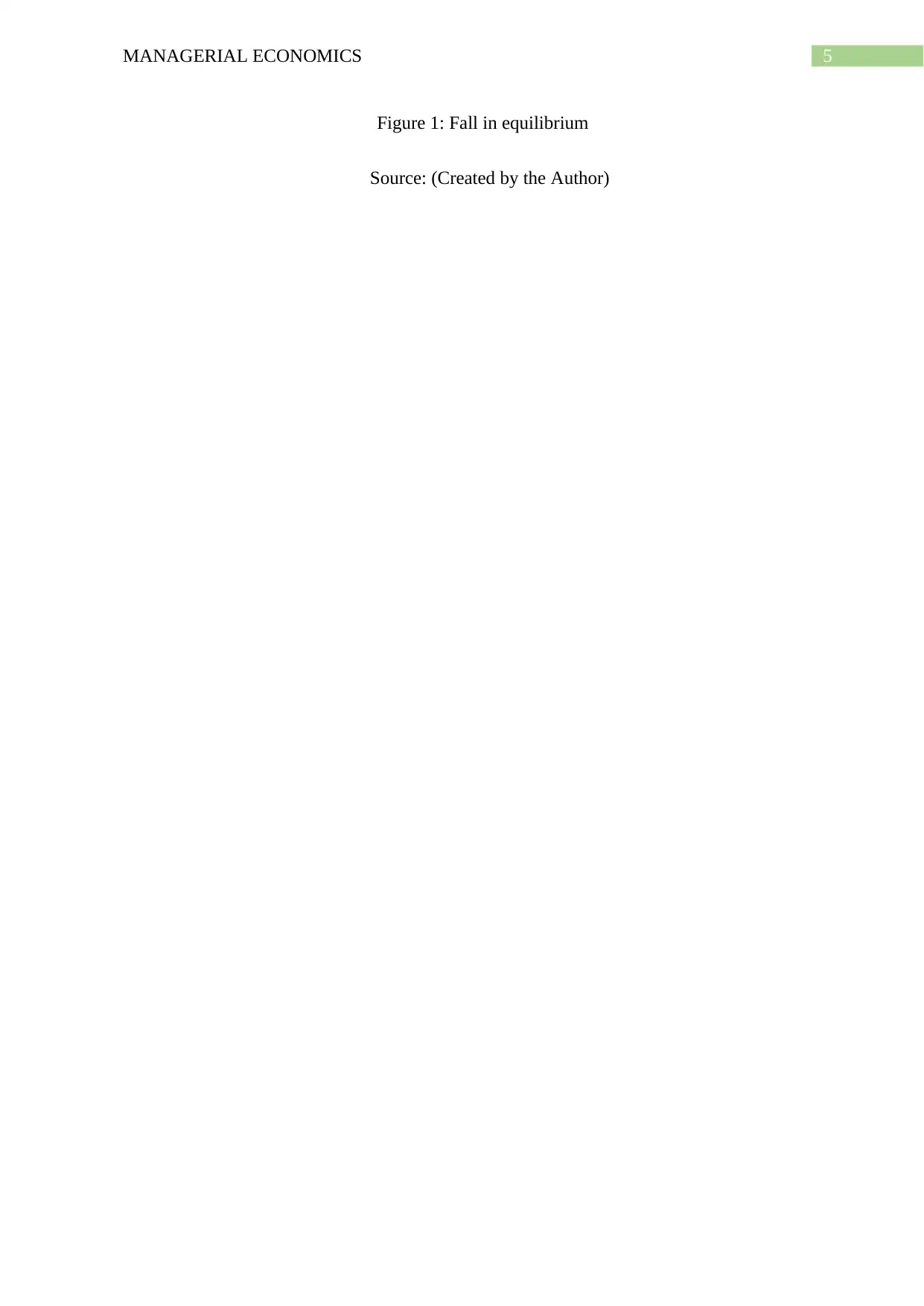
5MANAGERIAL ECONOMICS
Figure 1: Fall in equilibrium
Source: (Created by the Author)
Figure 1: Fall in equilibrium
Source: (Created by the Author)
⊘ This is a preview!⊘
Do you want full access?
Subscribe today to unlock all pages.

Trusted by 1+ million students worldwide
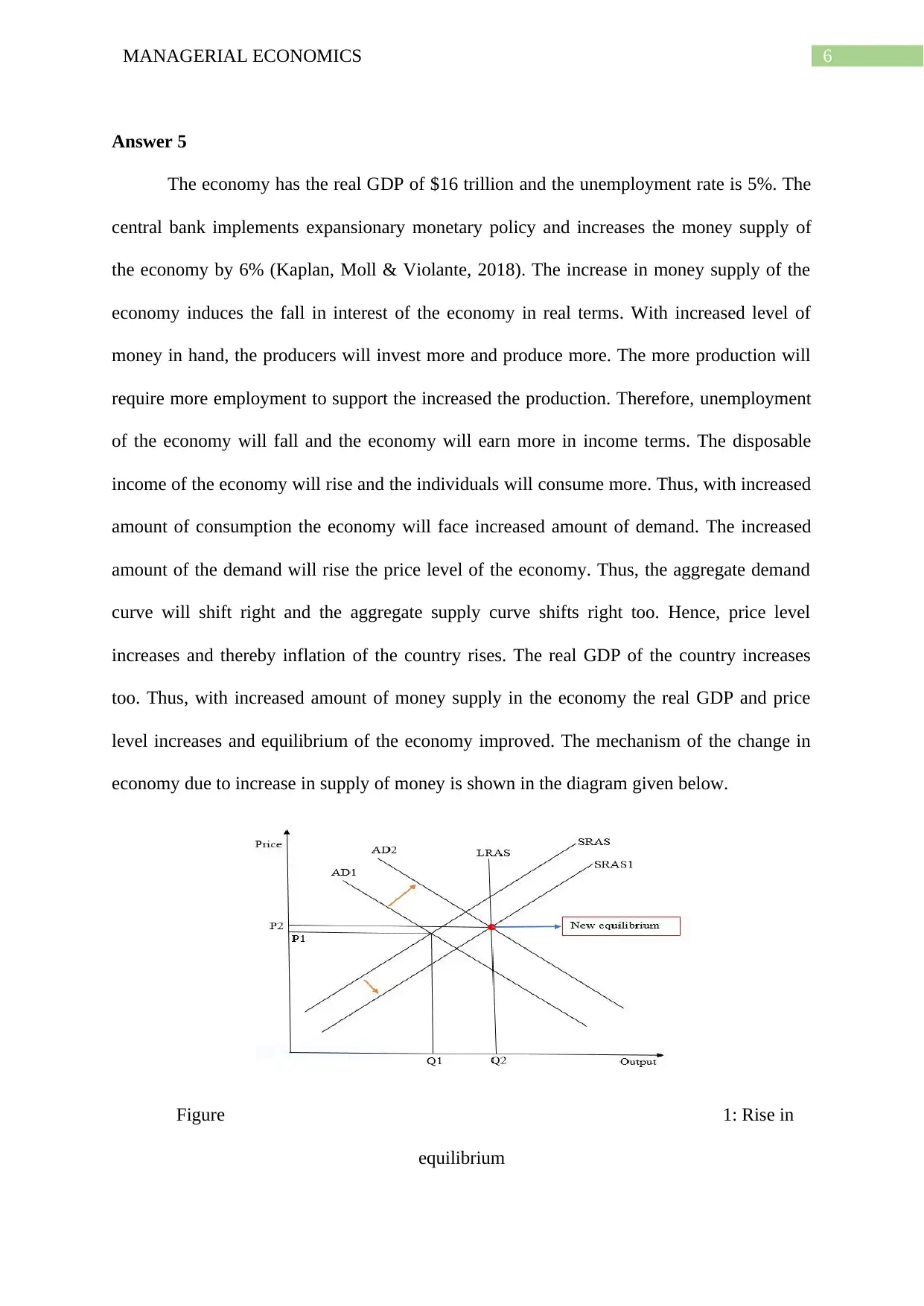
6MANAGERIAL ECONOMICS
Answer 5
The economy has the real GDP of $16 trillion and the unemployment rate is 5%. The
central bank implements expansionary monetary policy and increases the money supply of
the economy by 6% (Kaplan, Moll & Violante, 2018). The increase in money supply of the
economy induces the fall in interest of the economy in real terms. With increased level of
money in hand, the producers will invest more and produce more. The more production will
require more employment to support the increased the production. Therefore, unemployment
of the economy will fall and the economy will earn more in income terms. The disposable
income of the economy will rise and the individuals will consume more. Thus, with increased
amount of consumption the economy will face increased amount of demand. The increased
amount of the demand will rise the price level of the economy. Thus, the aggregate demand
curve will shift right and the aggregate supply curve shifts right too. Hence, price level
increases and thereby inflation of the country rises. The real GDP of the country increases
too. Thus, with increased amount of money supply in the economy the real GDP and price
level increases and equilibrium of the economy improved. The mechanism of the change in
economy due to increase in supply of money is shown in the diagram given below.
Figure 1: Rise in
equilibrium
Answer 5
The economy has the real GDP of $16 trillion and the unemployment rate is 5%. The
central bank implements expansionary monetary policy and increases the money supply of
the economy by 6% (Kaplan, Moll & Violante, 2018). The increase in money supply of the
economy induces the fall in interest of the economy in real terms. With increased level of
money in hand, the producers will invest more and produce more. The more production will
require more employment to support the increased the production. Therefore, unemployment
of the economy will fall and the economy will earn more in income terms. The disposable
income of the economy will rise and the individuals will consume more. Thus, with increased
amount of consumption the economy will face increased amount of demand. The increased
amount of the demand will rise the price level of the economy. Thus, the aggregate demand
curve will shift right and the aggregate supply curve shifts right too. Hence, price level
increases and thereby inflation of the country rises. The real GDP of the country increases
too. Thus, with increased amount of money supply in the economy the real GDP and price
level increases and equilibrium of the economy improved. The mechanism of the change in
economy due to increase in supply of money is shown in the diagram given below.
Figure 1: Rise in
equilibrium
Paraphrase This Document
Need a fresh take? Get an instant paraphrase of this document with our AI Paraphraser
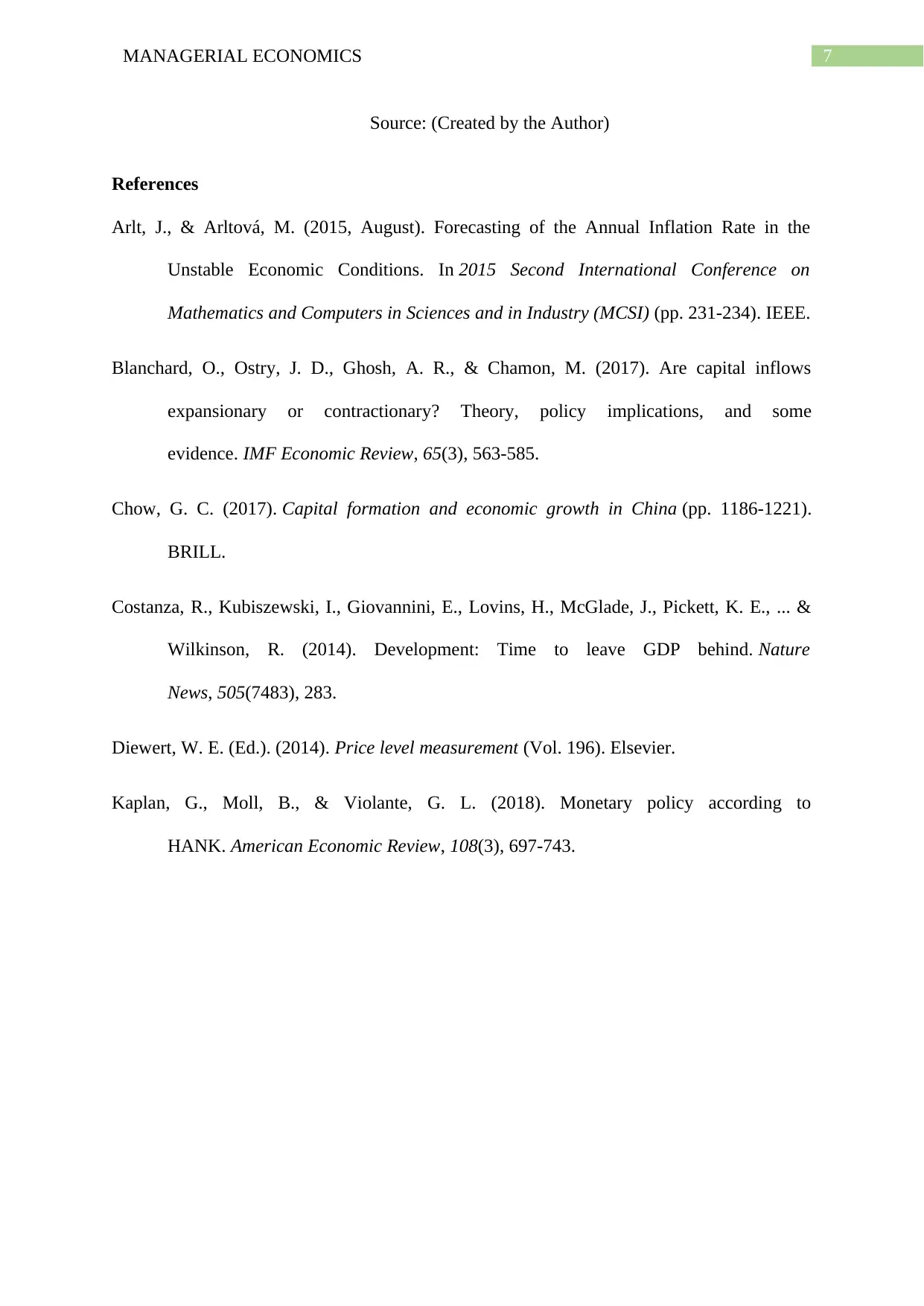
7MANAGERIAL ECONOMICS
Source: (Created by the Author)
References
Arlt, J., & Arltová, M. (2015, August). Forecasting of the Annual Inflation Rate in the
Unstable Economic Conditions. In 2015 Second International Conference on
Mathematics and Computers in Sciences and in Industry (MCSI) (pp. 231-234). IEEE.
Blanchard, O., Ostry, J. D., Ghosh, A. R., & Chamon, M. (2017). Are capital inflows
expansionary or contractionary? Theory, policy implications, and some
evidence. IMF Economic Review, 65(3), 563-585.
Chow, G. C. (2017). Capital formation and economic growth in China (pp. 1186-1221).
BRILL.
Costanza, R., Kubiszewski, I., Giovannini, E., Lovins, H., McGlade, J., Pickett, K. E., ... &
Wilkinson, R. (2014). Development: Time to leave GDP behind. Nature
News, 505(7483), 283.
Diewert, W. E. (Ed.). (2014). Price level measurement (Vol. 196). Elsevier.
Kaplan, G., Moll, B., & Violante, G. L. (2018). Monetary policy according to
HANK. American Economic Review, 108(3), 697-743.
Source: (Created by the Author)
References
Arlt, J., & Arltová, M. (2015, August). Forecasting of the Annual Inflation Rate in the
Unstable Economic Conditions. In 2015 Second International Conference on
Mathematics and Computers in Sciences and in Industry (MCSI) (pp. 231-234). IEEE.
Blanchard, O., Ostry, J. D., Ghosh, A. R., & Chamon, M. (2017). Are capital inflows
expansionary or contractionary? Theory, policy implications, and some
evidence. IMF Economic Review, 65(3), 563-585.
Chow, G. C. (2017). Capital formation and economic growth in China (pp. 1186-1221).
BRILL.
Costanza, R., Kubiszewski, I., Giovannini, E., Lovins, H., McGlade, J., Pickett, K. E., ... &
Wilkinson, R. (2014). Development: Time to leave GDP behind. Nature
News, 505(7483), 283.
Diewert, W. E. (Ed.). (2014). Price level measurement (Vol. 196). Elsevier.
Kaplan, G., Moll, B., & Violante, G. L. (2018). Monetary policy according to
HANK. American Economic Review, 108(3), 697-743.
1 out of 8
Related Documents
Your All-in-One AI-Powered Toolkit for Academic Success.
+13062052269
info@desklib.com
Available 24*7 on WhatsApp / Email
![[object Object]](/_next/static/media/star-bottom.7253800d.svg)
Unlock your academic potential
Copyright © 2020–2025 A2Z Services. All Rights Reserved. Developed and managed by ZUCOL.




